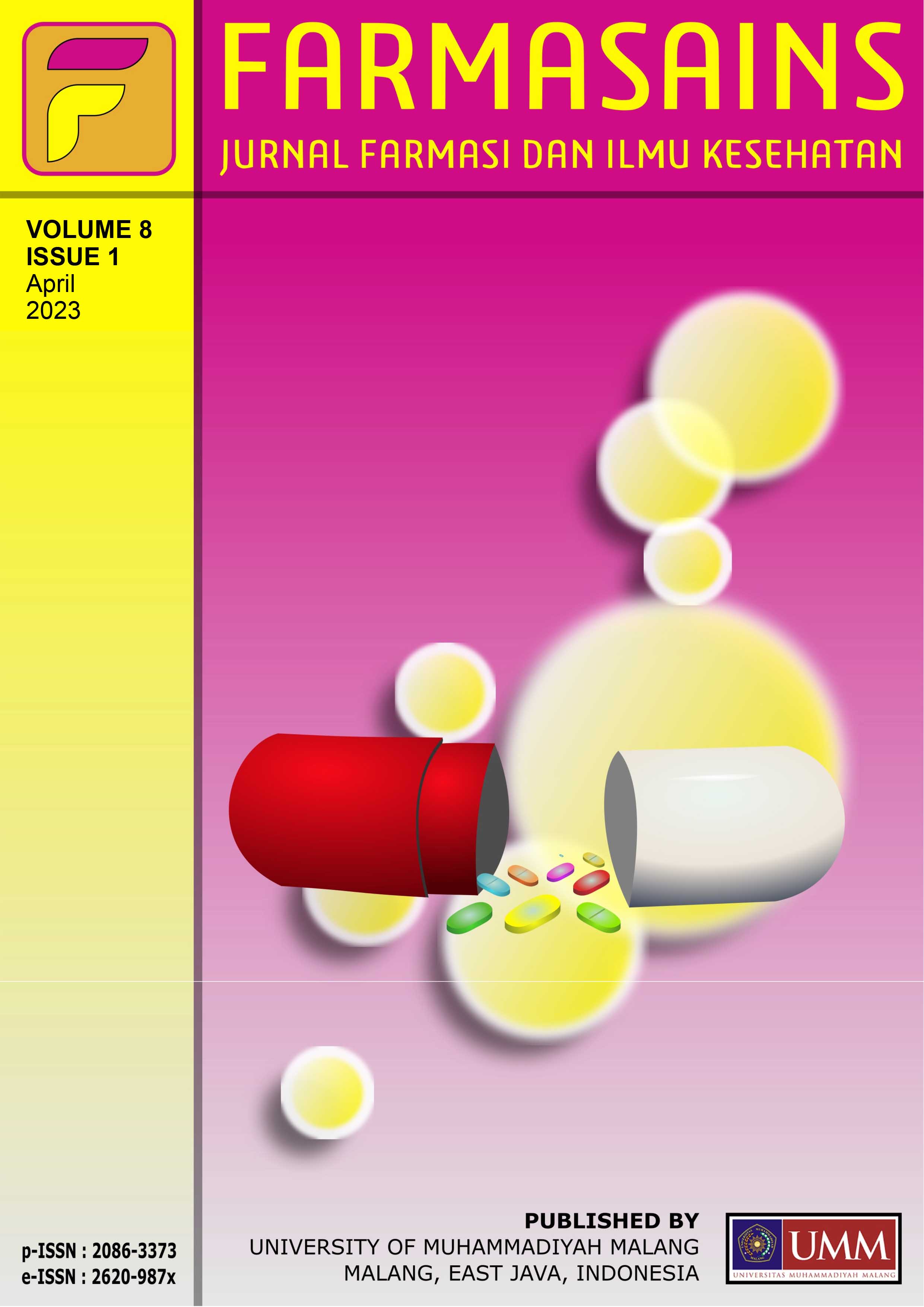Formulation And Physical Properties Evaluation Of Beach Morning Glory (Ipomoea Pescaprae) Leaves Ointment
DOI:
https://doi.org/10.22219/farmasains.v8i1.30572Keywords:
Physical stability test, extractAbstract
Background: Sea kangkung is one of the plants used as traditional medicine which is widely used as a topical medicine, one of which is to treat jellyfish stings and ulcers. This study aims to determine how to formulate ointment preparations from sea kangkung extract and to test the physical properties of sea kangkung preparations. Methods: Sea kangkung leaves were extracted using the maceration method using methanol as a solvent and then made preparations in the form of an ointment using concentration variations, namely (F1) - , (F2) 1 % , (F3), 3 % (F4), 5 % (F5) 10 %. Furthermore, the physical stability test of the ointment was carried out, namely the Cycling Test including organoleptic test, homogeneity test, pH test and spreadability. Results: The results obtained that sea kangkung extract ointment has a fairly good stability based on the stability test of the third formula, which is the most stable preparation.
Downloads
References
Akmal, M., Adam, M., Toras, M., R., & Lubis, IM (2015). Effect of Giving Pegagan Leaf Extract (Centella asiatica (L.) Urban) Against Testosterone Concentration in Rats.
Andayani, D., & Nugrahani, R. (2018). Phytochemical Screening and Antioxidant Activity Ethanol Extract of Katang-Katang Leaves (Ipomoea Pescaprae. L) from Lombok Island, West Nusa Tenggara. JPSCR: Journal of Pharmaceutical Science and Clinical Research, 3(2), 76.
Anief M. The Science of Compounding Drugs: Theory and Practice. 16. Yogyakarta: Gadjah Mada University Pres; 2013.
Ministry of Health, Jafpribik Indonesia- (1979). Paratope Indonesia Raisi MI Directorate General of POM, Jakarta.
Fuuta, S. 2016, Lotion Formulation and Determination of Sun Protection Factor (SPF) values.
Grag, A., D. Anggarwal., S Grag, AK Singla (2002). Spreading of Semisolid Formulations: An Update. Pharmaceutical Technology. September: 84-105.
Hermani MY, Mufrod M and Sugiyono S. Gecko (Gekko gecko L.) Water Extract Ointment Formulation for Wound Healing. Pharmaceutical Magazine 2012.
Illiang, I., Wulan, S., and Erfiana., 2017, Phytochemical Test of Dengen Fruit Extract. Journal of Dynamics, Vol 8 (1). Indonesia: Jakarta.
Mailuhu, M., Max RJ R., and Harry SJK, 2017, Phytochemical Screening and Antioxidant Activity of Soyogik (Saurauia bracteosa DC) Bark Extract, Chem prog, Vol. 1 (10).
Nilam, R., P., & Sumitra, C. (2018). Pharmacognostic and Phytohemical Studies Of Ipomoea Pes-caprae, An Halophyte from Gujarat. Journal of Pharmacognosy and Phytochemistry 2018.
Norman, A., 2007, Effect of Addition of Extracts of Temu Kunci (Boesenbergia Pandurata (Roxb.) Schlect.) and Kitchen Salt (NaCI) on the Storage Quality of Ripe Wet Noodles, Thesis, Faculty of Agricultural Technology, Bogor Agricultural University, Bogor.
Nugroho, AF, 2008, Formulation of Basil Extract Lozenges (Ocimum santum L.) in Wet Granulation Using Pulvis Gummi Arabici (PGA) as a binder, Thesis, Faculty of Pharmacy, UMS, Surakarta.
Rieger, M. Mi. (2000). litany's Cosmeticology 8th Edition, New York : Chomical Publishing Co. Inc.
Tranggoro R, Latifah F. Pegagan Book of Cosmetic Science. Jakarta: PT. Gramedia; 2007.
Voight, R., 1995. Pharmaceutical Technology Learning Book, 5th Edition translated into English by Neorono, S. Mada University Press, Yogyakarta. Gadjah Mada University Press.
Whardani, F. k., & Poedjirahajoe, (2020). Potential Utilization of Ipomena pescapre, (L.) R. Br. In the Coastal Forest of Kebumen Land. Journal of Forestry Science.
Wijaya, DP, Jessy, E., Paendonga., and Jemmy, A., 2014, Phytochemical Screening and Antioxidant Activity Test of Rice Leaf (Phrynium capitatum) Using the DPPH Method (1,1-diphenyl-2-picrylhydrozite), Journal of Mipa Unstrat Online, Vol 3 (1).
Yunus, I, Widdhi, B., and Edwin, DQ, 2018, Phytochemical Screening and Toxicity Test of Langsat Leaf Ethanol Extract (Lansium domesticum Corr) Against Artemia Salina Leach Larvae with Brine Shrimp Lethality Test (BSLT) Method, PHARMACON, Pharmaceutical Scientific Journal, Vol 7(3).
Downloads
Published
How to Cite
Issue
Section
License
Copyright (c) 2024 Meddo Lorenza Garnida, Delladari Mayefis, Habibie Deswilyaz, Diani Mega Sari, Arie Vonikartika

This work is licensed under a Creative Commons Attribution 4.0 International License.
Authors who publish with this journal agree to the following terms:
a. Authors retain copyright and grant the journal right of first publication with the work simultaneously licensed under a Creative Commons Attribution License that allows others to share the work with an acknowledgement of the work's authorship and initial publication in this journal.
b. Authors are able to enter into separate, additional contractual arrangements for the non-exclusive distribution of the journal's published version of the work (e.g., post it to an institutional repository or publish it in a book), with an acknowledgement of its initial publication in this journal.
c. Authors are permitted and encouraged to post their work online (e.g., in institutional repositories or on their website) prior to and during the submission process, as it can lead to productive exchanges, as well as earlier and greater citation of published work (See The Effect of Open Access).













